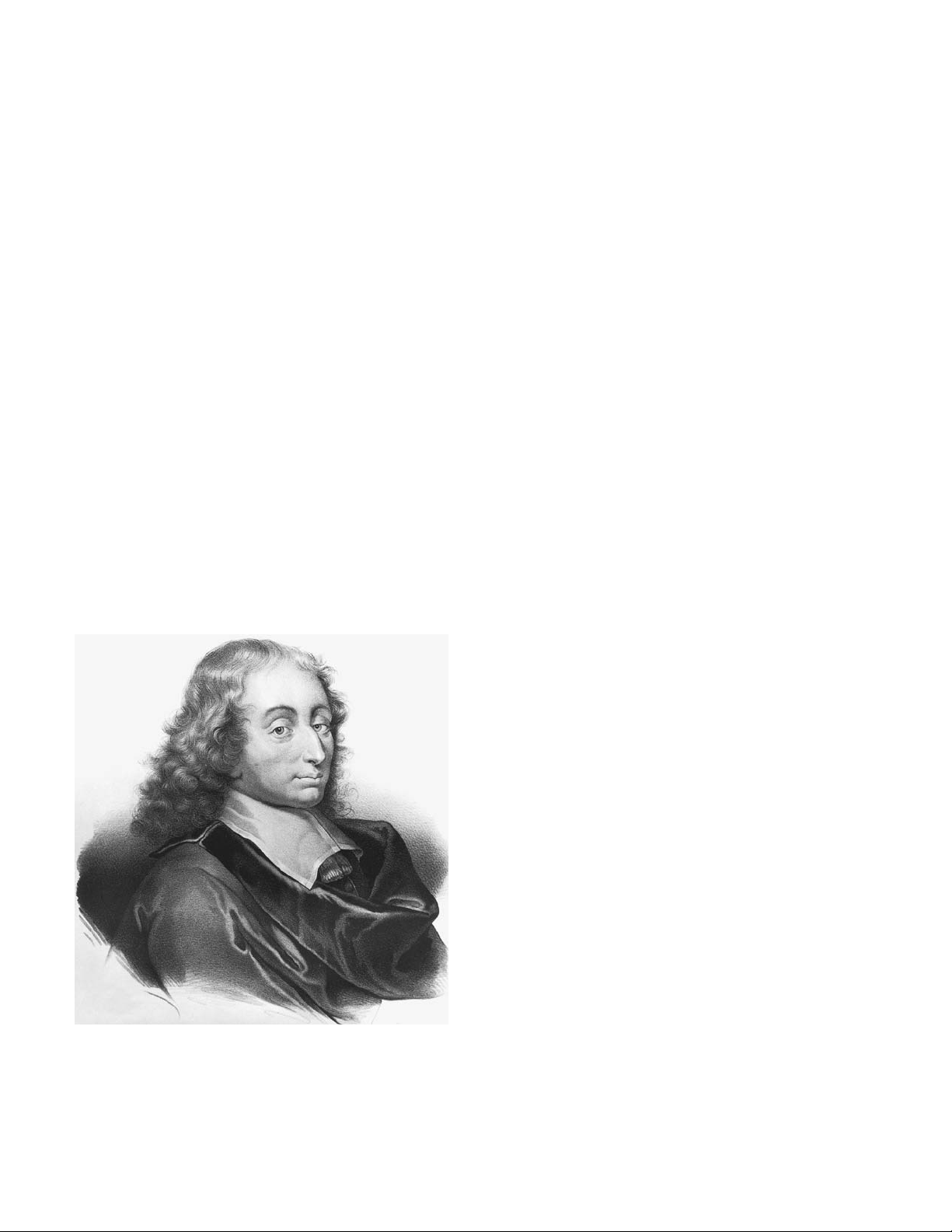
CYCLOID
and the development of ideas from this work
that led to the invention of
CALCULUS
.
Pascal was fascinated with mathematics as a young
teenager and by age 16 had already discovered a num-
ber of noteworthy results in the study of
PROJECTIVE
GEOMETRY
. He published his first work in geometry,
Essay on Conic Sections, in 1640.
In order to assist his father with his work in
recording and collecting taxes, between the years 1642
and 1645 Pascal invented and built a mechanical calcu-
lator that could perform sophisticated arithmetic com-
putations. Over the next 7 years Pascal oversaw the
construction of as many as 50 of these machines but,
sadly, few were sold. Production of the “Pascaline”
ceased, but Pascal is nonetheless noted as the second
person in history to have built such a device. (German
scholar Wilhelm Schickard built the first in 1624.)
In the late 1640s Pascal developed an interest in
hydrostatics and the properties of atmospheric pres-
sure. He published New Experiments concerning Vacu-
ums in 1647—a controversial work as scientists at the
time doubted that vacuums exist—and 4 years later his
famous piece Treatise on the Equilibrium of Liquids.
His interest in pure mathematics never wavered during
this time, and he continued to develop work on the the-
ory of
CONIC SECTIONS
. (Sadly, his manuscripts from
this period are lost to us today.)
In correspondence with P
IERRE DE
F
ERMAT
(1601–65), Pascal worked on solving two challenging
problems about games of chance: what is the
expected number of tosses required to roll a double 6
with a pair of dice? And how should one divvy up the
bets laid down for a game of dice, if the game must
be halted part way through its play? Pascal and Fer-
mat solved the first problem and the second only for
the case of a two-player game. This work marked the
beginning development of modern probability theory.
Pascal was a deeply religious man and is also
remembered for his famous line of rational thought
arguing in favor of believing in the existence of God.
Now called “Pascal’s wager,” Pascal’s argument simply
stated that if God does not exist, then nothing is lost by
believing in Him, whereas if God does exist, all will be
lost by not acknowledging His existence.
Pascal computed the arc length and area of one
branch of the cycloid curve, and also the volume and
surface area of a
SOLID OF REVOLUTION
obtained by
rotating it about the x-axis. This was his final mathe-
matical accomplishment before devoting his life to
religious service. He died of cancer on August 19,
1662, at age 39.
Although not remembered for having produced a
large body of profoundly creative work, Pascal did
nonetheless play seminal roles in the development of
several new fields of study (infinitesimal calculus, prob-
ability theory, projective geometry, and fluid statics, for
instance). He made significant contributions to each
field and, perhaps more important, played a significant
role in clarifying the foundations of these studies and
systematizing the methods they utilize.
Pascal’s distribution See
BINOMIAL DISTRIBUTION
.
Pascal’s triangle The triangular array of numbers
with 1 at the apex, with a 1 at the beginning and end
of each row, and with the property that each interior
number is the sum of the two numbers above it in the
preceding row is called Pascal’s triangle. The first few
rows of the triangle are shown below:
382 Pascal’s distribution
Blaise Pascal, an eminent scholar of the 17th century, is noted for
his pioneering work in the field of probability theory. (Photo
courtesy of Monique Salaber/The Image Works)